Autism Summit Conference Summary
A national conference focusing on the Federal government's role in biomedical autism research, early screening and diagnosis, and improving access to autism services was held November 19-20, 2003, at the Washington Convention Center in Washington, DC. The summit provided a public forum to disseminate, evaluate, and integrate the latest practice and science-based autism information among Federal, academic, and community participants.
Background and Meeting Goals
There is widespread concern about autism, partly resulting from increases in the reported prevalence rates for the disorder. This situation has led parents, community members, researchers and government officials to ask similar types of questions, such as: Who is doing research on autism? Can we accelerate autism research? Who is working on improving services for family members with autism? How can we enhance screening efforts for autism? One vehicle for gathering informed professionals and community members to discuss these issues is the Interagency Autism Coordinating Committee (IACC), formed in response to the Children's Health Act of 2000. The IACC serves to enhance coordination and effectiveness of autism research and service activities across the Federal government and with public stakeholders.
In order to create a public forum for addressing many of the pressing questions about how to proceed on a national level to advance autism research, as well as early identification and treatment, government and public members of the IACC formed a Conference Planning Committee, representing diverse interests and perspectives. This group worked collaboratively to plan the Autism Summit in a way that would expand the outreach of the IACC and create public dialogue to inform government initiatives. The summit provided an opportunity to highlight the Federal government's concern about autism and mobilize resources to confront this growing public health problem. The meeting signaled an important step in establishing a national agenda of research and service goals to be achieved through advances by federal, academic, voluntary, and other public organizations.
A major goal of the summit was to expand the work of the IACC and develop an information exchange among the autism community, experts in specific areas, and Federal agencies that advance autism research and services. Another goal was to foster partnerships among these groups. The U.S. Department of Health and Human Services (DHHS) and the U.S. Department of Education were co-sponsors of the conference. Sponsors from DHHS included The National Institute of Mental Health (NIMH), the National Institute of Child Health and Human Development (NICHD), the National Institute of Neurological Disorders and Stroke (NINDS), the National Institute on Deafness and Other Communication Disorders (NIDCD), and the National Institute of Environmental Health Sciences (NIEHS), as well as the Centers for Disease Control and Prevention (CDC), Center for Medicare and Medicaid Services (CMS), Health Resources and Services Administration (HRSA), and Substance Abuse and Mental Health Services Administration (SAMHSA).
The summit was segmented into three themes representing areas most urgently needing attention. The first theme was the integration of autism services throughout the lifespan. Topics included issues for those living with autism, such as fragmented services provided by educational and other systems. The second major theme, implementing autism screening and diagnosis, included presentations on existing screening instruments and implementation of screening practices in the community. Relevant research and current clinical practices were discussed. The third theme was biomedical research. In this component, programs were built on the work of an expert panel of scientists that responded to a congressional request for a "roadmap" to identify and advance high-priority research goals. Federal officials, researchers, and community members discussed such topics as genetics, epidemiology, and early intervention.
Members of the Government and Public Speak
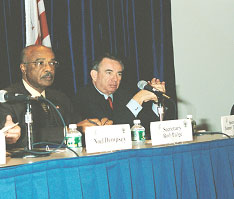
Dr. Rod Paige, Secretary of Education and Tommy Thompson,
Secretary of Health and Human Services, on the opening panel.
The opening morning of the conference highlighted the importance government officials are assigning to autism. Speakers included Congressmen Burton, Weldon, and Waxman, Secretary of Health and Human Services Tommy Thompson, Secretary of Education Dr. Rod Paige, and Director of NIH, Dr. Elias Zerhouni. Dr. Thomas Insel, Director of NIMH and master of ceremonies, opened by noting that although it has been 60 years since autism was identified, autism continues to remain a mystery, particularly with respect to causes and cures.
Presenting a parent's perspective, Jon Shestack, father of a child with autism, described "The Face of Autism."
He analogized autism to somebody sneaking into your house in the middle of the night and stealing your child's mind and personality. He emphasized the difficulty families face in receiving an adequate and timely diagnosis, the lack of urgency on the part of the public, and the lifetime economic burden of caring for a family member with autism. He told his personal story about his response to these issues, which included creating an advocacy organization and seeking out research to determine the economic reality, as well as the biological basis for autism.
Dr. Zerhouni ended the first morning session by emphasizing the need for collaboration between researchers, government officials, parents, and members of the autism community, using an integrated "roadmap" approach.
Congressman Waxman emphasized gains made in understanding autism, and mentioned four areas critical to furthering our understanding: basic science, epidemiology, clinical research, and translation into practice. Regarding diagnosis, the Congressman reported that the Centers for Medicare and Medicaid Services recently assigned a financial value to performing screening tests that identify developmental delay. Congressman Burton spoke passionately about his long-time commitment to autism. He expressed concerns about the possibility that vaccines containing thimerosal relate to the development of autism. Congressman Weldon followed, highlighting his concerns about therapies, treatments, and the role of genetics, and about the possible role of vaccines in autism.
Announcements of Public/Private Partnerships
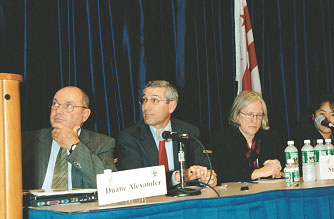
Duane Alexander, M.D., NICHD Director; Thomas Insel, M.D.,
NIMH Director; Story Landis, Ph.D., NINDS Director; and Prisca
Chen Marvin, Esq., President of NAAR
Dr. Duane Alexander, Director of NICHD, opened the session announcing four different public/private partnerships, stressing Dr. Zerhouni's statement about the importance of public/private partnership as a way to foster new approaches to research.
CAN Initiatives for Data Sharing: Jon Shestack from Cure Autism Now (CAN) and Dr. Steve Moldin from NIMH presented on collaborations between CAN and NIH in maximizing genetics data collection and sharing efforts. The speakers emphasized the importance of creating a gene bank and sharing genetic material to maximize research endeavors. The Autism Genetics Resource Exchange (AGRE) program was highlighted, as were their research procedures, which allow maximal family participation. The public/private partnership involves NIH funding of AGRE and other institutions that contribute to a centralized NIMH genetic repository. Donation of a software program, the Internet System for Assessing Autistic Children (ISAAC), by CAN was also discussed as a method for accelerating the data sharing process.
ASA/CDC Partnership: Autism Awareness Campaign: Dr. Jose Cordero from the CDC and Rob Beck from the Autism Society of America announced their collaboration to create a national Autism Awareness Campaign. Dr. Cordero called on the audience and relevant organizations to commit to the Autism Awareness Campaign, to help avoid unnecessary delays in early recognition. He also emphasized the power of hope and the promise of research. Mr. Beck stressed the boldness of the awareness campaign, as well as its national scope and broad-based focus. He emphasized goals of screening all children in the U.S. for developmental disabilities by age 3, thereby reducing the delay in diagnosis for children with autism and other developmental disabilities.
NICHD/National Alliance for Autism Research (NAAR) High Risk/Baby Sibling Autism Consortium: Building on the theme of early diagnosis and recognition, Dr. Duane Alexander announced the partnership between NICHD and the National Alliance for Autism Research, focusing on infant research on siblings of children with autism, to help identify early features and distinguishing characteristics of autism. A goal of this partnership is to create larger, combined samples of this population at high-risk for autism, in order to increase the statistical power of investigations.
NAAR Autism Genome Project: Prisca Chen Marvin announced the launching of the Autism Genome Project, with its goal of mapping the human genome in search of autism susceptibility genes. NIMH, NINDS, NIDCD & NICHD are four NIH institutes that have been involved in funding infrastructure to assist in this project. She described the unique opportunity afforded by this project, which includes expert geneticists from all over the world working together for a broader understanding of the genetics of autism. Dr. Story Landis, Director of NINDS, highlighted the effectiveness of parents in fostering both research and partnerships.
Theme on Services Across the Lifespan
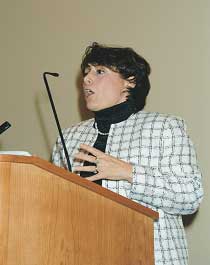
Joan Mele-McCarthy, D.A., Department of Education
Federal officials from the Department of Education, including Dr. Robert Pasternack, Assistant Secretary for the Office of Special Education and Rehabilitative Services, U.S. Department of Education, opened this session by calling attention to the powerful influence of parents, as the true experts on their children, the critical shortage of professionals working in special education, the explosive growth in the category of autism under special education, and the focus of special education on providing scientifically-based interventions. Three factors highlighted as contributors to the shortage of special education personnel were the overabundance of paperwork, the high frequency of meetings, and lack of administrative support (for more information, see http://www.ed.gov/about/offices/list/osers/). Dr. Pasternack also emphasized the need to provide sufficient training to special education teachers, and the need to reframe approaches to the topic of disability and the workplace.
The themes for the services sessions were: supports (family, natural, mentoring, job coaching, etc.); access to services; major life transitions; interventions; inclusion of individuals with autism in developing a competent workforce; and systems/resources integration (i.e., school, community, medical). Concurrent sessions featured panels of speakers who addressed the following themes: Birth to Five/Early Childhood, School Age (K through 6th grade), Adolescence/Secondary/Transition, and Adults. The themes were addressed in terms of "best practices" or "what works" with comments on the existence or need for scientific research to support best practices. In addition to individual presentations, a facilitator extracted issues to be addressed in a national policy agenda that were reported to the whole group at the end of the afternoon.
Session A: Early Child/Birth to Five: Merle McPherson, M.D., HRSA, moderated this session that included the following speakers: Adrian Sandler, M.D., Mission Children's Hospital; Sue Baker, Autism Services Consultant, Child Health Specialty Clinic; Juliann Woods, Ph.D., CCC-SLP, Florida State University; and Jeff Sell, Autism Society of America. Bonnie Strickland, Ph.D., HRSA, served as the facilitator.
All of the presenters referred to the following 10 elements of an early childhood autism program: 1) A primary medical care "home" to foster early screening, detection, intervention and follow-up. 2) Collaboration between health plans, physicians, families, and schools is essential, but interactions must be changed to promote true "community" implementation and translation of research to practice. While the prevalence of autism is rising, the number of adequately trained professionals is not. 3) Physicians, early intervention providers, and families all need training on the development and use of best practice guidelines for working with children with autism spectrum disorders (ASD). 4) It is important that the age of identification and entry into early intervention be reduced in order to optimize child development. 5) Evidence-based interventions with characteristics demonstrated to be effective, including those that are intense, flexible, coordinated, accessible, and collaborative, should be implemented. 6) Best practice suggests that early developmental screening should be developed and implemented as a mechanism for earlier detection and intervention. 7) Practitioners, researchers and policy makers must support families in obtaining consistent and full information about the basic signs of autism. 8) Early intervention is important for implementation of strategies to ensure that communities are fully inclusive of individuals with autism spectrum disorders in the various aspects of life (e.g. school, recreation). 9) Infrastructure should be improved to ensure that existing, evidence-based programs are available to all children who need them. And finally, 10) Strategies that improve accessibility of essential services, including health care, early intervention, care coordination, and program expansion to children with autism and their families, should be implemented.
Session B: School-Age: Dr. Gail Houle, Office of Special Education Programs, U.S. Department of Education moderated this session, and speakers included Ilene Schwartz, Ph.D., University of Washington; Cathy Pratt, Ph.D., Indiana Institute on Disability and the Community; Andrew Baumann, M.A., New York Families for Autistic Children; and Robin Welsh, M.S., M.A., Esq., Department of Special Education, Calvert County, MD. Beth Caron, Ph.D., Office of Special Education Programs, U.S. Department of Education, served as the facilitator.
Professional development was emphasized in these talks, and enhanced training was suggested for general education professionals as well as special education professionals, pediatricians, and paraprofessionals. Training and certification issues were discussed in terms of how parents can assist in the effort to improve training. Methods included talking to superintendents and engaging in grass-roots efforts with other parents. Issues of collaboration with parents were also highlighted, such as ensuring that parents are members of the educational team. Ways to help parents in their advocacy efforts were also described, and particular emphasis was given to the importance of bringing data about the child to the table.
Session C: Secondary/Transition: Dr. Joan Mele-McCarthy, Department of Special Education and Rehabilitative Services, U.S. Department of Education, moderated this session, and speakers included Susan Levy, M.D., Children's Hospital of Philadelphia; Teresa Grossi, Ph.D., Indiana Institute on Disability and Community; Jim Ball, Ed.D., Sawtelle Learning Centers; and Mayer Max, M.S., SharkaTech Research and the Veterans National Healthcare Volunteer Portal. Merlene Sion-Burroughs, Ph.D., Office of Special Education Program, Department of Education, facilitated this session.
Key issues discussed during these sessions included the need for enhanced support services, such as peer support and mentoring, and the need to focus on social skills in particular, for this age-group. Transitions of several kinds were highlighted, emphasizing the need to employ effective intervention packages that stress generalization skills, self-advocacy and self-determination training. It was noted that the use of evidence-based practices should not be restricted to entire programs, as it may be important to utilize components within different programs. The importance of relationships with other resources (e.g., vocational training services) was highlighted, to work together to implement transition programs that have tangible outcomes. There was also a call to establish a system of chronic care that includes coordinated care management, medical management and family support.
Session D: Adults: This session was moderated by Lee Grossman, President, Autism Society of America, and speakers included Stephen Shore, Anna Hundley, Executive Director, Autism Treatment Centers of Texas and President, National Association of Residential Providers of Adults with Autism; Evelyn Milorin, Kenney Fellow, Office of Special Education Programs, U.S. Department of Education; and William Kiernan, Ph.D., Adjunct Professor, Graduate College of Education University of Massachusetts. Jenn Rigger, M.S., Rehabilitation Services Administration, facilitated this session.
General messages that were presented included the need for enhanced coordination of adult services, particularly with respect to the transition from child to adult services, and the need for service personalization, due to the wide range of services needed by different individuals and families. Mr. Shore spoke on the autism spectrum from the perspective of an adult, and outlined four problems areas and potential solutions for adults: 1) gaps in service provision due to lack of appropriate service agencies, 2) underemployment and unemployment, 3) need for self-advocacy and awareness of civil rights, and 4) higher education challenges. Ms. Hundley described the model of adult services provided at her service agency, including residential facilities, and vocational training. Ms. Milorin spoke as a parent of an adult with autism, focusing on a needed paradigm shift to break down barriers for adults living with autism. Dr. Kiernan emphasized the need for comprehensive supports for adults, which include community living, recreation, and laborforce participation.
Expert Panel: A panel that included presentations from experts in the field concluded this session. Dr. Pasternack moderated this session, and speakers included David Holmes, Ed.D., President and Executive Director, Eden Services; Robert Koegel, Ph.D., Counseling/Clinical/ School Psychology Program, University of California, Santa Barbara; Stanley Greenspan, M.D., Clinical Professor of Psychiatry, Behavioral Sciences, and Pediatrics, George Washington University of Medical School; Ivar Lovaas, Ph.D., Executive Director, Lovaas Institute of Early Intervention; Lee Grossman, President, Autism Society of America; and Ruth Christ-Sullivan, Ph.D., Autism Services Center.
Dr. Christ-Sullivan opened the session, emphasizing the gains made in the last 30 years with respect to research and education. She described a comprehensive, service-based center that serves individuals with autism across the lifespan. Dr. Greenspan emphasized a model of functional and developmental capacities, and made program recommendations that included 1) a mid-career fellowship program for special educators to become updated on the latest information and become leaders in their communities, 2) the importance of exploratory realistically-based treatment research that reflects complex models, and 3) course-of-life programming in the community that focuses on creative activities, such as drama. Dr. Koegel discussed the need to help parents and professionals with stress reduction, and highlighted the importance of not only randomized controlled trial research, but also single case design research that allows for investigation of who responds to treatment and why. Mr. Grossman stressed the realities of the increasing prevalence and economic burden of autism, the difficulties with gaining access to appropriate services, the need for training of service providers, and the need to convey the best practices (described at the meeting) to the community. Dr. Holmes discussed important principles for optimally serving individuals with autism across the lifespan, including the necessity of providing structured learning environments and providing vocational and adaptive training at young ages. Dr. Lovaas described the development of his model of Applied Behavior Analysis, as well as important behaviors to focus on in treatment. He also described the theory behind the intervention, and important predictors of response to treatment.
Theme on Developmental Screening
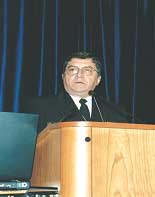
José Cordero, M.D., MPH, Centers for Disease
Control and Prevention
Developmental screening refers to a brief assessment designed to identify children who should receive more intensive diagnosis or assessment. Such procedures can improve child health and well being, especially for children with autism and other developmental disabilities or delays. This session highlighted the challenges and progress in making developmental screening an integral part of primary care. The session was action-oriented, demonstrating what is currently being done either in a research or practice setting that is promising.
Keynote speakers for this theme included Dr. Barry Zuckerman from Boston University, Dr. Peter Mundy from the University of Miami and Dr. José Cordero of the Centers for Disease Control and Prevention (CDC). They highlighted the importance of developmental screening in the early identification of children with autism and other developmental disorders, why this is important, what works, and what we can do now to achieve this goal.
Three breakout sessions, entitled, The "How To's: A Tool Box for Developmental Screening" followed the format of 2-3 speakers highlighting ongoing research or practice models followed by a panel discussion composed of important stakeholders (parents, practitioners, and early education providers) who discussed their perspectives on the major issues. These sessions included, "How to build awareness among parents, practitioners, and educators," "How to test—Best tests and why," and "How to put into practice-Best models."
How to build awareness: Dr. Lucille Zeph moderated this session, which included presenters Nancy Wiseman, founder of First Signs, Inc; Katherine Lyon Daniel, Ph.D., Associate Director of Behavioral Science and Health Education at the National Center on Birth Defects and Developmental Disabilities, CDC/DHHS; Lee Grossman, President of the Autism Society of America; Adrian Sandler, M.D. of Mission Children's Hospital; and Margaret Dunkle, Senior Fellow, Department of Health Policy, George Washington University. The focus of this session was how to close the gap in knowledge between parents and providers in recognizing the early signs of autism. Parents' knowledge was emphasized, as was the need for providers to listen to parents. Programs such as First Signs, a national non-profit organization dedicated to educating parents and physicians about the early warning signs of autism and other developmental disorders, were described.
How to Test - Best Tests and Why: Speakers in this session included Frances Page-Glascoe, Ph.D., Associate Professor of Pediatrics, Division of Child Development, Vanderbilt University School of Medicine; Amy Wetherby, Ph.D., Professor of Communication Disorders, Department of Communication Disorders, Florida State University; and Deborah Fein, Ph.D., Professor of Psychology, University of Connecticut. Wendy Stone, Ph.D., Professor of Pediatrics and Psychology and Human Development, Vanderbilt University, served as the discussant. This session reviewed both developing and in-use screening assessments, with the general notion that developmental screening instruments need to be implemented in pediatric and other medical and educational settings. When necessary, developmental screening should be followed by comprehensive autism-specific assessment.
How to Put into Practice: Marian Earls, M.D., of Guilford Child Health Inc., moderated this session, which included speakers Ed Schor, M.D., of the Commonwealth Fund; Jennifer Pinto-Martin, Ph.D., Associate Professor, University of Pennsylvania School of Nursing; and panel discussants: Jim O'Brien, Ph.D., of the Agency for Children and Families, Head Start Bureau; Mary M. Gottesman, Ph.D., Assistant Professor, College of Nursing, Ohio State University; Paul Dworkin, M.D., Professor and Chair, Department of Pediatrics, University of Connecticut; and Eric London, M.D., co-founder and Vice Chair of Scientific Affairs, NAAR. This session focused on how to put all aspects of screening together. Descriptions were given of exemplary model programs that have successfully implemented screening practices into general community settings. Policy gaps were highlighted, such as the discrepancies between Age 0 to 3 services compared to programming for older children in the educational system.
Theme on Biomedical Research
The biomedical research theme of the conference was initiated with a plenary presentation made by Congressman Christopher Smith, co-chair of the congressional autism caucus - Coalition for Autism Research and Education. He emphasized that "no stone should be left unturned" when it comes to finding out about causes and treatment for autism, emphasizing the need to adequately fund research, to provide respite care for parents and caregivers, and to pass the TEACH Act legislation that could advance the training of teachers who work with individuals with autism.
Dr. Thomas Insel provided a keynote speech for this theme, which included a rollout of the matrix Congress has required the IACC to generate describing high priority autism research activities for the next decade, including areas such as epidemiology, etiology, genetics, diagnosis, behavioral expression across the lifespan, neuroscience, the development and evaluation of efficacious interventions, and other topics. The material presented built on the work of an expert panel of scientists that met in July 2003 to provide extensive input for the matrix of research goals and activities that was mandated in the conference language for the NIH FY 2003 appropriations bill. Dr. Insel emphasized the strongly heritable nature of autism, highlighting the breakthroughs that may be possible when specific genes for vulnerability to autism are identified.
Following the initial plenary presentation, three sessions addressed specific areas in the matrix of research goals: genetics research, epidemiological and environmental research, and early intervention research. Panels with representation from expert scientists, community members, and governmental officials led these interactive sessions. Expert scientists summarized current knowledge, big questions, and roadblocks to answering these questions. Each session was used to engage the group in discussion to address the following issues with respect to research in each area.
Early Intervention: Dr. Geraldine Dawson summarized what is known about early intervention, including that early intervention makes a difference, and there is a lot of variability in how children respond. Cost benefit analyses are beginning to show how beneficial early intervention can be, but we still do not know what factors determine the effectiveness of specific interventions. Richard Fade emphasized the need for a community perspective, as well as collaboration and multidisciplinary work, and the need for improved data and research on health aspects of care for children with autism. The Autism Treatment Network was highlighted as a new organization focused on accelerating the process of collecting and disseminating knowledge in these areas.
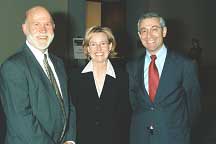
Steve Foote, Ph.D., NIMH; Geraldine Dawson, Ph.D.,
University of Washington; and Thomas Insel, M.D., NIMH Director
Genetics: Dr. Daniel Geschwind summarized the state of knowledge with respect to genetic findings in autism. The genetic complexity of autism was emphasized, as was the excitement of newly created large databases that will allow "the needle(s) in the haystack to be illuminated." Dr. Andy Shih again emphasized a major new collaborative initiative to identify genes contributing to autism.
Epidemiology/Environment: Dr. Judy Grether and Rick Rollens spoke about prevalence and risk factors. Increases in prevalence were described, although reasons for these increases have not been determined. Dr. Grether described existing roadblocks to uncovering the true prevalence of autism around the country, which include logistical as well as research barriers. Environmental factors, such as pollutants, possibly contributing to the increases were discussed, as were immunity-related issues. Resources such as twin registries and population-based studies were described as potentially extremely useful in investigating these issues. Dr. Ian Lipkin, a professor of neurology, anatomy and neurobiology, and Kathleen Berry, an active community member and parent, also spoke about environmental factors. Dr. Lipkin outlined research tools that can be used to discover potential environmental factors and their mechanisms, such as animal models, and prospective epidemiological studies. Ms. Berry gave personal insight into the costs of raising a child with autism. She talked about issues related to trust between parents and the research community, and gave examples of her own involvement as a parent advisor to a large-scale study.
Summit Closure
The summit ended with a plenary session to summarize and integrate the break-out sessions. Dr. Insel closed by noting how this conference will be used as a launching point, not only for the autism research matrix, but also for a variety of groups that will continue to work together.


